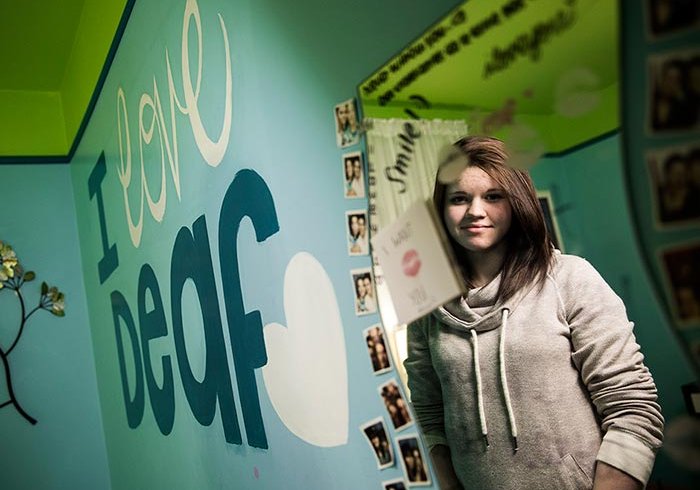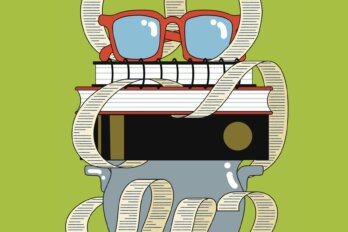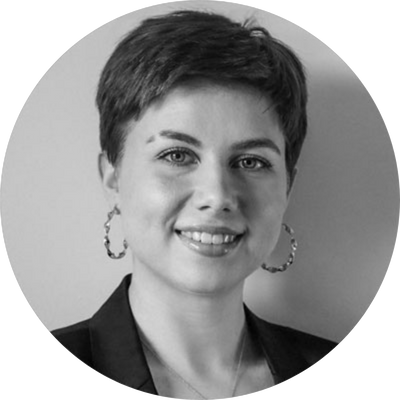When she was two, her name was a loop with thumb and three fingers, her index raised—D—then brought up to touch her nose: nez. Then her name was a wall of static, vibrations artificially bypassing her damaged cilia to directly stimulate the auditory nerve, the chatter slowly dialed into sense by audiologists and speech therapists. She said its parts out loud: Da… Daph. She wrote it on school notebooks and medical forms: Daphnée Ménard. At seventeen, her name is a loop with thumb and three fingers, index raised—D—then the flash of a tattooed forearm as she lifts both hands to her face, thumbs and fingers extending on either side of her mouth: smile.
In 1995, when Daphnée Ménard was born, there were complications, and the doctor prescribed her a strong antibiotic called gentamicin. Over the next six months, her parents noticed that she was living in her own world: she didn’t react to the blaring television, or heavy things crashing to the ground, or their voices. “Of course, it was hard for us to accept,” Nicole acknowledges. She has light brown bangs and a ponytail, and she and Daphnée exchange a look while Nicole and her husband, Mario, laugh shamefacedly. They have been through this before, but it is tough to say in front of their daughter that she did not come out the way they had hoped. “You’re angry. You can’t believe it. You grieve, essentially.”
The family lives in Candiac, a Montreal suburb on the south shore of the Saint Lawrence, in a neighbourhood where the streets are named for composers: Grieg, Handel. After Daphnée’s diagnosis, her parents started taking her downtown several times a week to learn Quebec’s distinct sign language, langue des signes québécoise, or LSQ, and they learned a bit themselves. They consulted with audiologists, teachers, psychologists, and doctors, and when she was two they decided to have her fitted with a cochlear implant, a transmitter that would send sound vibrations to her brain. They drove up to Quebec City for the operation. “The first time Daphnée heard something,” Nicole says, “she turned and gave us this very serious look.” Mario adds, “With her eyes bugging out.”
Physically, she adjusted well, attending the local school and becoming adept at lip-reading, to fill in what her implant didn’t catch. She learned to enunciate clearly, and when I meet her I am shocked by how natural her pronunciation is. But emotionally, she felt “like an extraterrestrial,” she says. Her hair is dyed dark brown with a red sheen, and she has a round moon of a face with Disney cartoon eyes, a rumpled forehead, and expressive lips. Although Nicole tried to keep up signing with her at home, by the time Daphnée was six she was embarrassed to use LSQ around other kids. Up until grade ten, she was the only deaf kid in her school. Her head throbbed from the concentration required to read lips and filter noise all day, and she would come home and take it out on her parents and her little sister, Ariane. “I was depressed. I had dark thoughts,” Ménard says. Even when she started high school, made more friends, and became popular, she still felt isolated and unhappy.
The capital-d deaf community and identity came late to Quebec. In the 1850s, deaf entrepreneurs in the US were already so sure of themselves as a distinct society that they proposed a political solution: separatism. “I suggest,” wrote deaf educator William Martin Chamberlain in an open letter to the American Annals of the Deaf and Dumb in 1858, “that when a sufficient number of mutes, with their friends, are found, as I have no doubt there might be, they emigrate to some previously selected spot in the west, and buy up a piece of land six miles square…. They could regulate their own affairs, build and plant, and would no doubt grow to be a respectable colony.” Canada’s first enduring school for the deaf opened in Montreal in 1848, and the Institution Catholique des Sourds-Muets was run by an order of priests called the Clercs de Saint-Viateur. (A sister institution for girls, run by nuns, was established three years later.) Where the American Annals of the Deaf and Dumb published debates on Deaf self-governance, the Quebec equivalent, L’Ami des Sourds-Muets, was issued by the school’s clergy. It ran letters more like this one from Louis Duchesne of Rimouski, printed in February 1936, about a different kind of self-governance: “I have learned from the papers about the death of the good friar Caron. I sympathize with all my heart with your community and Institution…. I really like your beautiful book Le mariage chrétien, it will help me stay on the straight and narrow path through life.” In 2013, the school and its legacy are undergoing a physical and emotional gutting; the imposing grey stone building, on boulevard Saint-Laurent at the south corner of Parc Jarry, is being hollowed out and converted into condos, and the Quebec Superior Court is hearing a class action suit by more than seventy-five former students who have accused twenty-eight priests from the school of ongoing sexual abuse.
The power the clergy held over deaf students in the nineteenth and twentieth centuries has had long-lasting repercussions from a linguistic standpoint. Initially, a sign language originating in France was used for instruction. In the 1880s, the oral method came into vogue, and sign languages were forbidden. Gestural communication was prohibited in class and even at recess, but in the dormitories at night deaf students continued to sign in secret, and the mix of the schools’ original signed instruction and the signes clandestins shared at night by children from different regions formed a contact language that developed into today’s LSQ.
Signed languages escaped the notice of most linguists until the 1960s, because it was assumed that hand movements, facial expression, and tilt of the body were not speech. As with spoken languages, each is different. Although all share a high degree of iconicity—signs are often modelled on the appearance of what is being described—what is iconic to one person may not seem so to another. LSQ and LSF (langue des signes française, the language initially used at the Institution Catholique des Sourds-Muets) share an intertwined history, but their iconic words are mutually unintelligible. In LSQ, the sign for “horse” is two hands in front of the chest, thumbs and pinkies extended. In LSF, it is both hands brought to the temples with the index and middle fingers raised. Both are iconic, but with the LSQ sign the hands look as if they are holding the reins; in the LSF sign, the hands are the horse’s ears.
It was not until after the Quiet Revolution and the 1963 Parent Report, in which control over education was transferred from the Church to the government, that Quebec’s Deaf community started to mobilize around sign language rights. The recognition of LSQ as distinct, separate from the American Sign Language used by deaf anglophones, had a pleasingly nationalist flavour, and in 1981 the first LSQ dictionary was developed by Raymond Dewar, Paul Bourcier, and Julie-élaine Roy. The Parent Report, however, grouped deaf kids with other disabled kids, and it recommended that these children be integrated into their neighbourhood schools rather than ghettoized in separate environments. Then, as now, the Deaf community tended to disagree.
The deaf population, in Quebec and in Canada, is small. Statistics Canada has been unable to develop a question that elicits reliable answers about the number of deaf Canadians, in part because questions about deafness have been framed as disability questions, and many deaf people do not view themselves as disabled. The Canadian Association of the Deaf therefore uses a statistical convention, estimating that Canada’s deaf population is roughly one-tenth that of the US, or approximately 350,000 people who are profoundly deaf, with another possible 3.2 million who are hard of hearing. Researchers estimate the number of LSQ speakers at 5,000 or 6,000, most of whom live in Quebec and Ontario.
Separate schools for the deaf across Canada have closed or seen their enrolments drop in the past few years. Some 90 percent of deaf children are born to hearing parents, who usually have no previous exposure to Deaf culture; especially since cochlear implants became an option, these parents tend to want their kids to be mainstreamed. CAD, an advocacy organization with a mandate to protect Deaf culture, has agitated to keep separate schools open. “The deaf child in a regular school is usually isolated,” the association’s website reads. “In a Deaf school, on the other hand, the child is exposed to many other Deaf people and role models, as well as to the Deaf culture; he/she finds a true home.”
In Quebec, only two schools offer the “bilingual/bicultural model,” in which deaf students are taught using a mix of French and LSQ. In 1869, anglophone Quebecers established their own deaf residential school, the Mackay Institution in Montreal, and while the city now runs the MAB-Mackay Rehabilitation Centre the small school serves a diverse group of special-needs students. Anglophone parents are more likely to send their deaf children to the Montreal Oral School for the Deaf, which was founded in 1950. It does not teach sign language, and its aim is to develop audition via hearing aids and cochlear implants.
Providing culturally and linguistically sensitive education for deaf people is tricky, even for specialists. Quebec’s deaf Inuit students were sometimes sent south to Montreal for schooling, and staff at the Mackay Centre proceeded to instruct them in ASL—not realizing that they already had their own sign language. “I think I’m going to be fried in hell for this,” says Jamie MacDougall, former executive director at Mackay. He now travels to northern communities to videotape elders signing, and is working toward the first glossary of Inuit Sign Language, or ISL. The Nunavut government recognized ISL in 2009, and MacDougall is helping to establish a curriculum to teach it in schools. The flash cards he is developing, which are quadrilingual, in ISL, Inuktitut, ASL, and English, show some interesting points of divergence. In ASL, the sign for “woman” involves the back of the thumb stroked downward along the cheek, an iconic sign left over from the days when women wore bonnets that tied under the chin. The ISL sign is more frank: the flash card shows both hands describing half-circles over the chest.
When you are a teenager, one party can change your entire life. The party that changed Daphnée Ménard from deaf to Deaf—a medical condition versus a cultural identity—happened one night when she was fifteen, and, as with any momentous social event, at first she was nervous about going. “My friend said, ‘Come on, there’ll be people signing. It’s super-fun, you’ll see.’ I kind of hesitated, because I was really just in the hearing world at that point,” she says, sitting cross legged on the brown leather couch in her parents’ basement. When she walked into the party, she heard some kids speaking French—the oralist ones who, like her, had been coached to speak and read lips; some, like her, with implants. The others were using a language Ménard dimly remembered: the hand gestures, facial expressions, and sweeping arm movements of LSQ. “When I talked to the people there,” she says, “it was really something special, because they had all lived the same thing as me. It was at that moment that I first thought, I’m not alone.” Her voice, usually brash and matter-of-fact, drops in wonder.
She started going to Deaf social events, hanging out every Friday night at a cultural centre in Montreal to play pool and sign LSQ. “Within a year and a half, I was signing perfectly,” she says. That summer, she went to a camp for deaf youth at Notre-Dame-de-l’Île-Perrot, where she met a boy from Ottawa. They started dating, and he convinced her to try something: going out in public without her cochlear implant. Part of Ménard’s implant is embedded in her skull, but there is also an external microphone that clips onto her ear, connected by a wire to a transmitter she must wear on a belt. It can be awkward to move around with, as well as a fashion liability, but she had never gone out without it.
“At first, I was like, if I’m going out in public I have to wear my implant. People don’t sign, so I have no choice.” But her boyfriend showed her how to get around. “If I’m in a restaurant, I’ll ask for a paper and pencil, like this”; she draws a square in the air with her fingers and makes a writing motion. “I’ll write down, I want a hamburger, I want this and that.” Initially, she felt weird showing that she was deaf, and especially because she can speak it felt weird not to. But as she came to accept and feel proud of her Deaf identity, she began to think that maybe it was not all up to her to fit herself into a hearing world. Maybe others could also make an effort to accommodate her.
In September 2012, she recorded a video in LSQ and posted it on YouTube. It is called “My Opinion on Cochlear Implants,” and in it she looks angry. She signs:
All day, I stayed patient. I listened to my teacher. When the day was done and I got back home, I cried almost every night. I was not happy… The government is stupid to think that if an implanted child can talk and communicate, everything will be perfect and work out fine… Being Deaf is like a religion. A Deaf needs to be with other Deaf, why? Because we are the same. We think alike and understand each other!… This is my message: if a child is born deaf, keep him deaf! This is this child’s identity and reality. Later, when he is older, he may choose…. If I had to start my life over, for sure I would not have gotten the cochlear implant.
But what makes Deaf culture so distinctive? “Even for me,” says Ménard, “I find it really hard to explain.” Sometimes when she speaks French, her fingers give a lexical twitch, moving to half-form a sign. “I ask my friends sometimes, other Deaf, like, What is it? I know there’s a difference! But it’s really rare to find someone who can give an answer.”
One way of seeking these answers is through art, and Montreal has an active Deaf arts scene. I brought an interpreter with me to meet Pamela Witcher, an artist in her late thirties with a septum piercing and asymmetrical blond hair. She is one of the linguistic elite in the Deaf community—a Deaf child of Deaf parents—and she is considered part of the De’VIA movement, Deaf View/Image Art. Her work shows many stylistic hallmarks of De’VIA: she paints in strong contrasts, and pays particular attention to the body language and facial expressions of the figures in her compositions. She lives and works in a loft in an old industrial building in the Rosemont–La Petite-Patrie borough of Montreal, along with her Deaf fiancé and deaf cat. “It’s actually quite hard to find a deaf cat,” she remarks.
When I ask how she sees the future of the Deaf community in Montreal, she says it’s not the cochlear implant itself that bothers her. It’s that kids like Ménard who get the implant and are absorbed into mainstream society have such a hard time finding their way back to the community. When the implant was first approved for use in children in the mid-1980s, many viewed it as a form of genocide. History has not been kind to deaf people: they were euthanized in Nazi Germany, and Alexander Graham Bell’s eugenicist beliefs led him to spend much of his life working to prevent deaf marriages, and to write “Upon the Formation of a Deaf Variety of the Human Race.” When I spoke to Martha Perusse, the director of the Montreal Oral School, she said, “The implant changed the world for hearing impairment completely, and I don’t know what the next phase will be—probably gene development or gene therapy.” Not all deaf people consider themselves culturally Deaf, but for those who do the idea is hard to countenance. “Some people feel that using the word ‘genocide’ is a bit of an exaggeration, but I don’t feel it is an exaggeration of the problem,” Witcher says. Sitting at her kitchen table, her back to her own bright canvases, she starts to cry. “In the past two years, we’ve really talked about this a lot.”
When I met Ménard, five months after she made her first YouTube video, it had garnered more than 15,000 views and a great deal of commentary, mostly from other deaf individuals sharing their experiences, both positive and negative, of the cochlear implant. By the time I spoke with her, some of her opinions had changed. She still thinks that children should not be implanted without their permission, before they are old enough to choose for themselves. However, “if I had it to do over,” she says, “I would have the implant. I know it gives me advantages, like I can talk on the phone, and communication is easier. What I would change is to have stayed more in the Deaf community. For me, that’s what was missing in my life.”
It is not surprising that Ménard’s mother and father wanted her to be part of the majority. Parents want their children to belong to the same language group they do, and suddenly having a child who is a permanent foreign exchange student in their home is difficult to accept. But the intrinsic value we attach to spoken language may be more culturally specific than we realize. In MacDougall’s travels among Inuit communities, he has found that even though the North is sparsely inhabited and there may only be one or two deaf people in a community, they are not pushed to speak and lip-read. It is hearing people who adapt by learning to sign.
This appeared in the May 2013 issue.






